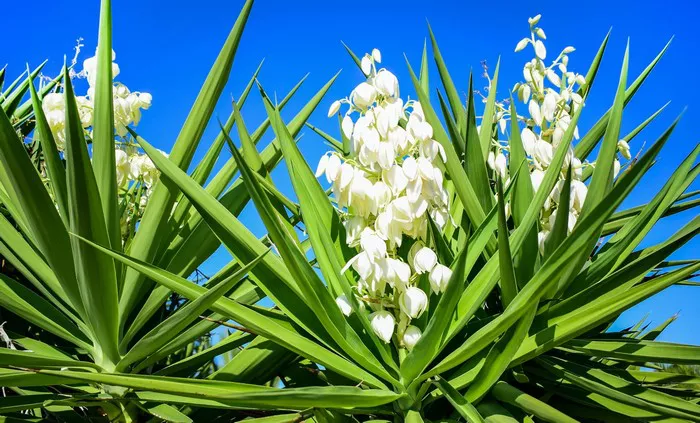Yucca plants are renowned for their striking foliage and unique flowers, which add a touch of exotic beauty to gardens and landscapes. While yuccas are primarily known for their architectural foliage, their flowers also hold significant allure. Understanding the anatomy, variations, significance, and cultivation of yucca flowers can enhance appreciation for these remarkable plants and assist in their successful cultivation.
Anatomy of Yucca Flowers
Yucca flowers exhibit a distinctive anatomy that sets them apart from other flowering plants. They typically feature six petal-like tepals arranged in a radial symmetry. Tepals are undifferentiated floral parts that resemble both petals and sepals, and in yucca flowers, they often have a waxy texture and come in various colors, including white, cream, yellow, and even greenish hues.
The central part of the yucca flower comprises reproductive organs, including stamens and pistils. Stamens are the male reproductive organs that produce pollen, while pistils are the female reproductive organs responsible for seed production. Yucca flowers are notably adapted for pollination by specific yucca moth species, which play a crucial role in their reproductive cycle.
At the base of yucca flowers, there is a structure called the ovary, which contains ovules that develop into seeds upon fertilization. Once pollination occurs, the ovary swells and matures into a fruit, often referred to as a capsule or pod, containing numerous seeds.
Variations in Yucca Flowers
Yucca flowers exhibit remarkable diversity in terms of size, color, and form across different species and cultivars. Some species, such as Yucca filamentosa, commonly known as Adam’s needle, produce tall spikes adorned with creamy white flowers that bloom in late spring to early summer. Others, like Yucca gloriosa, feature pendant clusters of bell-shaped white flowers that attract pollinators with their sweet fragrance.
Variations in flower color are also notable among different yucca species. While white is the most common color, some species, such as Yucca aloifolia, bear yellowish or greenish flowers, adding to the intrigue of these plants. Additionally, hybridization efforts have led to the development of cultivars with unique flower colors, including shades of pink, purple, and coral.
Apart from color, the size and shape of yucca flowers can vary significantly. Some species produce large, showy blooms that can reach several inches in diameter, while others have more modest flowers nestled among dense foliage. The architectural form of yucca flowers adds to their appeal, making them a focal point in garden landscapes.
Significance of Yucca Flowers
Yucca flowers hold cultural, ecological, and aesthetic significance, making them prized additions to gardens and natural habitats alike. Culturally, yucca flowers have been revered by indigenous peoples for their versatility and symbolism. Native American tribes used various parts of the yucca plant for food, fiber, and medicinal purposes, while the flowers often held spiritual significance in rituals and ceremonies.
Ecologically, yucca flowers play a vital role in supporting pollinator populations, particularly yucca moths (Tegeticula spp.), which have a specialized mutualistic relationship with yucca plants. Female yucca moths collect pollen from yucca flowers and deposit it onto the stigma of other flowers while laying eggs inside the developing ovaries. This pollination process ensures the continuation of both yucca plants and yucca moth populations, highlighting the ecological importance of these floral interactions.
Aesthetically, yucca flowers contribute to the visual appeal of landscapes, whether in natural habitats or cultivated gardens. Their architectural form, combined with a diverse range of colors and textures, adds visual interest and contrast to outdoor spaces. Yucca flowers are particularly valued for their ability to thrive in arid and drought-prone regions, where they provide bursts of color amidst harsh environmental conditions.
Cultivating Yucca Flowers
Cultivating yucca flowers requires careful attention to their unique requirements, including soil, sunlight, water, and maintenance practices. Here are some essential tips for successfully growing yucca plants and encouraging abundant flower production:
1. Selecting the Right Location: Yucca plants thrive in well-drained soil and full sunlight, making them ideal for xeriscaping and drought-tolerant landscapes. Choose a sunny spot with sandy or loamy soil for optimal growth.
2. Providing Adequate Drainage: Yucca plants are susceptible to root rot if they are planted in poorly drained soil. Ensure that the planting site has good drainage by amending the soil with sand or gravel if necessary.
3. Watering Wisely: While yuccas are drought-tolerant once established, newly planted specimens may require regular watering until they develop a robust root system. Water deeply but infrequently to encourage deep root growth and avoid overwatering.
4. Pruning and Maintenance: Remove dead or damaged leaves and spent flower stalks to promote a tidy appearance and encourage new growth. Be cautious when handling yucca plants, as their sharp, sword-like leaves can cause injury.
5. Fertilizing Sparingly: Yucca plants are adapted to nutrient-poor soils and generally do not require heavy fertilization. Apply a balanced fertilizer sparingly in spring to promote healthy growth and flowering.
6. Protecting from Extreme Cold: While many yucca species are cold-hardy, prolonged exposure to freezing temperatures can damage tender growth and flower buds. Consider providing winter protection, such as mulching or covering with frost cloth, in colder climates.
7. Encouraging Pollinators: To maximize flower production and ensure successful pollination, encourage native pollinators, such as bees and moths, to visit your yucca plants. Avoid using pesticides that may harm beneficial insects.
By following these cultivation guidelines, gardeners can enjoy the beauty of yucca flowers and create thriving landscapes that celebrate the unique charm of these iconic plants.
Conclusion
In conclusion, yucca flowers are not only visually captivating but also hold ecological, cultural, and aesthetic significance. Their distinct anatomy, diverse variations, and cultivation requirements make them intriguing subjects for gardeners and plant enthusiasts. Whether adorning arid landscapes or adding a touch of exotic beauty to garden beds, yucca flowers continue to captivate and inspire admiration worldwide.


